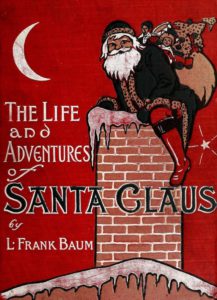Father Christmas, Saint Nicholas, St. Nick, Papa Noel, Julenissan, Sinterklaas, Kriss Kringle, Santa Claus, there are many names for this jolly old elf. You’ll recall Santa is called an “elf” in the 1823 poem “The Night Before Christmas” written by Clement Clark Moore (1779-1863). We think of him today as a jolly, rotund gentleman as depicted by the Coca-Cola Company since the 1920s. Moore’s poem describes Santa and his sky ship as miniature. Big or small, the legend of Santa Claus — or whatever he’s called around the world — has captured the hearts and minds of young and old.
Saint Nicholas was born about A.D. 270. He was known for giving gifts to the ill and poor at year’s end and for his love of children. He died about A.D. 343 on Dec. 6, which is now The Feast of St. Nicholas. It is said that to save a man’s three daughters from ill fate — no dowries — Saint Nicholas dropped bags of gold down their chimney which landed in the stockings the girls had hung there to dry. This is starting to sound a lot like our Santa Claus.
Before 1800, Christmas was strictly a religious holiday in America. Since then, the addition of a chubby gentleman delivering gifts for children down chimneys added a bit of fun to the sacred day. After 1800 many Americans had some disposable income because of the Industrial Revolution which allowed them to purchase mass-made and commercialized presents. In 1820 stores advertised to encourage Christmas shopping. Books and poems and songs were penned such as the beloved 1843 story “A Christmas Carol” by Charles Dickens (1812-1870) which encouraged folk to not be stingy with gift giving, to put up a celebratory tree, have a day off and to bathe in the spirit of family and friends. The catchy 1857 tune “Jingle Bells” takes us for a ride in Santa’s sleigh, and Santa Claus was “Up on the Housetop” in a tune from 1864. Folks began bringing live evergreen trees into their homes and decorating them to celebrate the season. Santa Claus was a central element to this festive atmosphere of days off, gift giving and decorating. Santa even started showing up in department stores around 1841, enchanting amazed, starry-eyed children who would swamp him with the list of gifts they hoped to receive.
Many of today’s images, words and beliefs of Santa Claus come from immigrants to America. The Dutch called him Sinterklaas which became Santa Claus. In Scandinavia Santa’s sleigh was pulled by eight goats; we substituted reindeer. A ninth reindeer, Rudolf, appeared because of Robert Lewis May’s (1905-1976) book “Rudolf the Red-Nosed Reindeer” penned in 1939. Cookies and milk left for Santa by grateful children probably came from Norse mythology and the story of Odin and his horse Sleipnir. The children hoped Sleipnir would leave gifts for them in thanks for carrots they left. English households leave mince pies and sherry or Scotch — like my dad did — for Santa. In Ireland the cookies may be washed down with beer.
Thomas Nast (1840-1902), a Civil War cartoonist from old Bavaria famous for drawing the donkey of the Democratic Party and the elephant of the Republican Party, depicted Santa Claus in an 1881 drawing that has stood the test of time. Nast shows Santa smoking a pipe and as portly, with a plump tummy. He has a white beard, mustache and hair adorned with holly and wears a red outfit trimmed in white fur cinched with a gold-buckled belt. He has a sack on his back and is clutching many toys. Nast drew at least 33 depictions of Santa Claus until 1886 that were published in Harper’s Weekly. Nast would later develop the ideas that Santa lived at the North Pole, and employed elves in his workshop.
Santa Claus has evolved through the ages and has taken various forms around the world. The Santa equivalent in Iceland, Jolasveinar (Yule Lads) refers to 13 troll-like tricksters. In Russia, Ded Moroz (Grandfather Frost) often dons blue or white and wears his beard quite long. For the Japanese, Hotei represents Father Christmas and a more modern version depicts Mr. Claus as Colonel Sanders in a Santa suit. The Japanese have taken to wolfing down buckets of the Kentucky fried bird at Christmas instead of turkey or goose. Whatever form your Saint Nicholas takes, keep joy in your heart, show kindness and compassion to those around you and enjoy the magic of the season.
Barbara enjoys history and the traditions of the Christmas season. She can be reached at [email protected].

Let's keep in touch!
Keep up with the latest OutLook by the Bay information by signing up here. We promise not to waste your time.



